#chikamatsu monzaemon
Explore tagged Tumblr posts
Text

4 notes
·
View notes
Text


L’arte è un qualcosa compreso nel più sottile margine tra il reale e l’irreale.
13 notes
·
View notes
Photo

Chikamatsu Monzaemon, The Love Suicides at Amijima (trans. Donald Keene)
41 notes
·
View notes
Text
Tosca 🤝 Love Suicides at Amijima
theatrical productions about a het couple who die fearing getting caught by authorities, at least one by suicide
a known and feared kinda rich guy in town bullies female lead into almost hooking up with him instead of running off with the male lead
male lead is kind of a disaster and has a reputation as fragile as paper but otherwise he fairly gets by; there are moments in which he feels betrayed by his lover
writing oaths on paper that don't really get to be kept in the end
somebody in both of these plays dies by a knife twist to the guts and then their corpse gets laid out in a more dignified position
#giacomo puccini#tosca#operablr#opera tag#opera#chikamatsu monzaemon#the love suicides at amijima#kabuki#bunraku#心中天の網島
0 notes
Text
"His work often features individuals caught in a conflict between ethical and personal demands."
on Chikamatsu Monzaemon from The Literature Book: Big Ideas Simply Explained, James Canton
leave a little kindness
#juli-quotes#juli-the-literature-book#the literature book#james canton#big ideas simply explained#japanese#japan#japanese literature#history of literature#conflict#academia#dark academia#light academia#classic#classics#classical#classic literature#monzaemon#chikamatsu#chikamatsu monzaemon
1 note
·
View note
Text
Recently Viewed: The Oil-Hell Murder
If you’ve seen one film inspired by playwright Monzaemon Chikamatsu’s work, you’ve pretty much seen them all. Gonza the Spearman, Night Drum, and the aptly titled A Story From Chikamatsu revolve around the same basic tropes: forbidden love, adultery, the conflict between personal morality and social obligation, tragedy, pyrrhic victory, reluctantly pursued vendettas. The specifics may vary, but the overarching structure remains strictly formulaic—consistent, dependable, and predictable.

Fortunately, Hideo Gosha brings some much-needed vitality to his adaptation of the otherwise painfully conventional The Oil-Hell Murder. The director reins in the manically kinetic visual style familiar to fans of his contributions to the chanbara genre; here, his camerawork is patient and methodical, observing the drama with a cold, voyeuristic detachment. Every edit is precise and economical; whenever possible, he adjusts the framing and blocking rather than cutting, lingering on such subtle details as a glistening puddle of spilled oil or the frayed ends of a broken sandal thong. Even something as simple as a dirty over-the-shoulder shot crackles with electricity; in one scene, for example, the protagonist is almost entirely obscured by her costar, leaving only her eyes visible—her stony, tear-dampened gaze clearly conveying the maelstrom of passion, lust, rage, fear, and doubt tormenting her psyche.
While it’s not as boldly innovative as Masahiro Shinoda’s Double Suicide, The Oil-Hell Murder is a taut, efficient, and deliciously suspenseful cinematic interpretation of well-worn theatrical traditions; if you’re acquainted with Gosha solely through his action-adventure movies, this is required viewing.
#The Oil-Hell Murder#Hideo Gosha#Monzaemon Chikamatsu#Japanese film#Japanese cinema#jidaigeki#Criterion Channel#film#writing#movie review
3 notes
·
View notes
Text
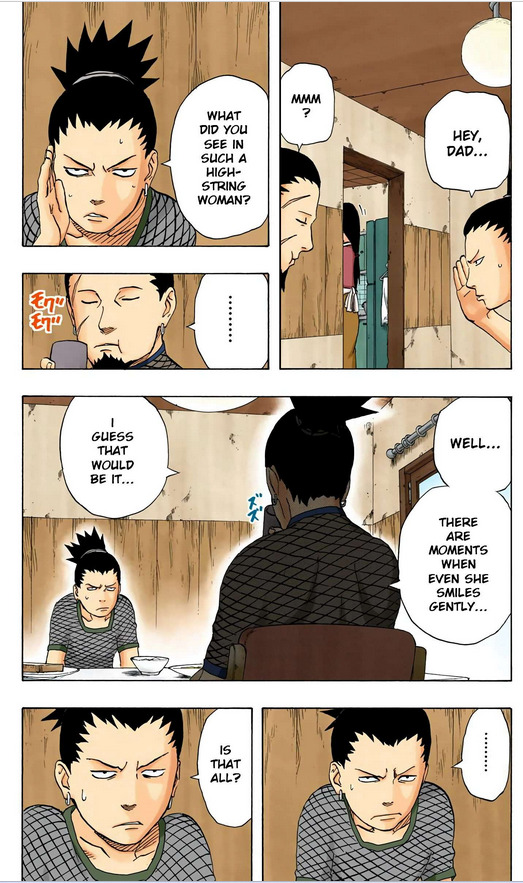
Chapter 182 (beginning of Sasuke retrieval arc).
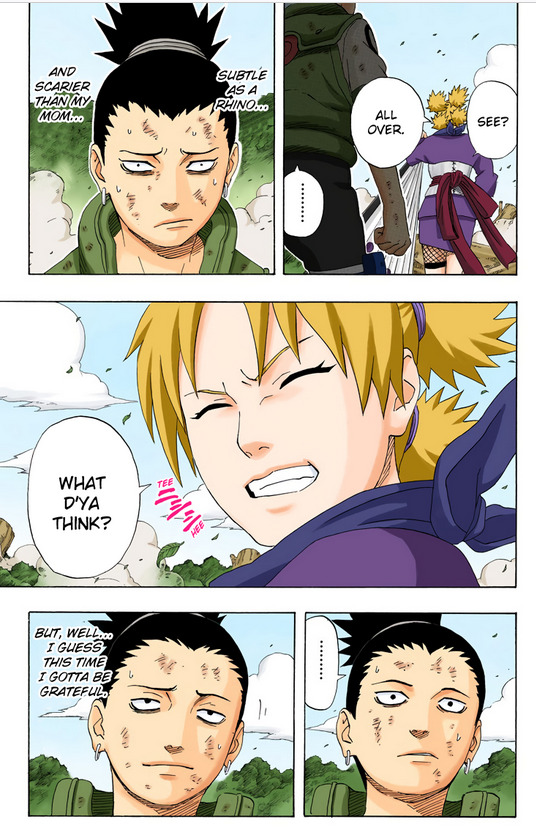
Chapter 214 (near the end of Sasuke Retrieval arc, 32 chapters after the first image). I think everyone can see the obvious foreshadowing and call-back Kishimoto made here.
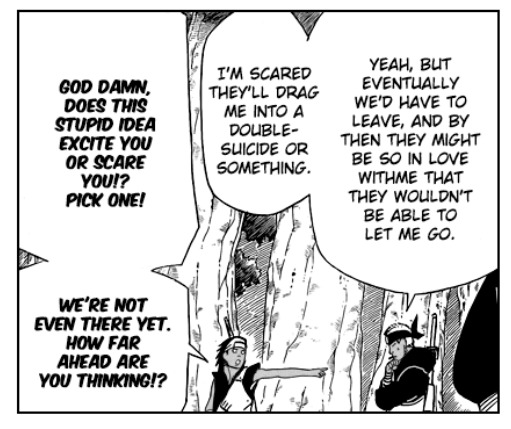
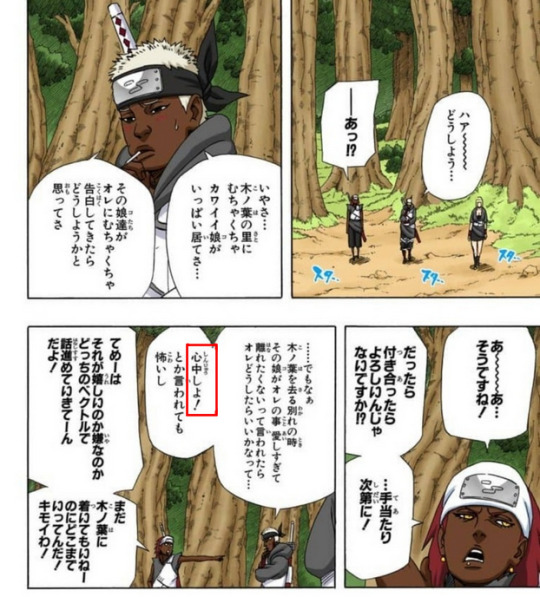
Chapter 450 (beginning of the Five Kage Summit arc).
心中 (Shinjū) - double/lovers suicide.
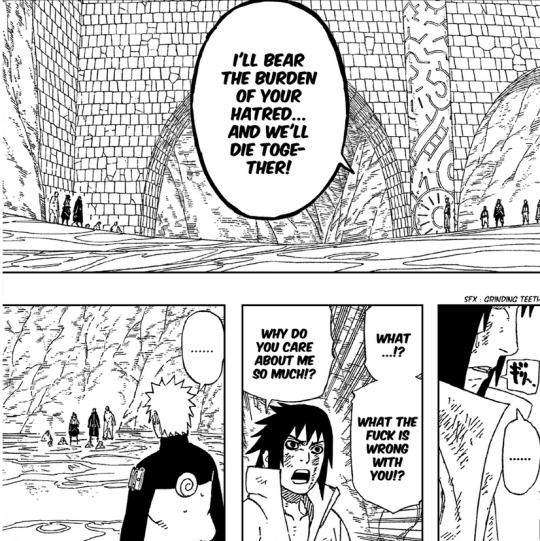
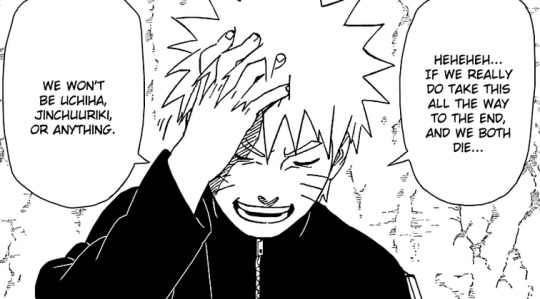
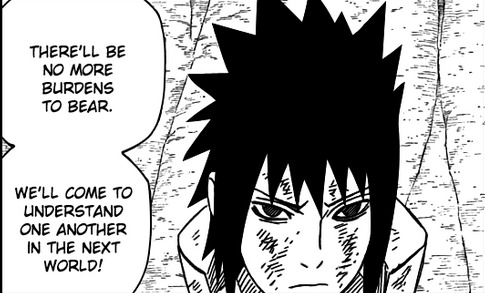
Chapter 486 (End of Five Kage Summit arc, 36 chapters after the first image).
Random mention of double-suicide and someone not being able to let the person they're in love with go. Naruto suggesting double-suicide to Sasuke because he can't bare to let Sasuke go. He wants to be with Sasuke in the next world, and is ready to leave his dream and everyone else behind for Sasuke.
Kishimoto is a big fan of Chikamatsu Monzaemon, (I have mentioned this many times, he used his name for the creator of puppetry jutsu in Naruto) who was literally known for his double-suicide romantic plays. The idea of being together in the next world because you can't be in this one is a famous romantic trope and very popular in Japan. SS shippers will bring up the most obscure proof for SS, but they will close their eyes for this blatantly obvious proof that Kishimoto intentionally wrote Naruto and Sasuke romantic. This is not a brotherly dynamic written here, not in any sense of the word. Unless you are illiterate. So yes, keep saying Kishimoto does things "accidentally" when I literally over and over again show you plainly that he does use literary tools like any writer does, in this case FORESHADOWING.
Kishi knew what he was doing ❤️ Naruto is a love story. This post is for the reading comprehension gang.
405 notes
·
View notes
Text
It's very likely that a manga artist has seen a movie based on a popular comic, and may have been inspired by it and referenced it in their work.
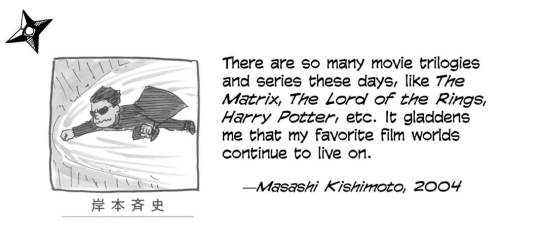
1. Argonath on the River Anduin and The Valley of the End are so similar-looking
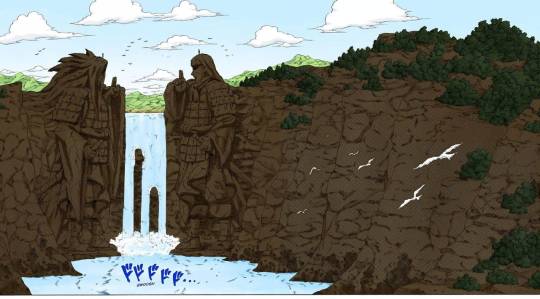
Valley of the end - 2004

The Lord of the Rings: The Fellowship of the Ring- 2001 [it premiered in Japan on March 2, 2002]
2. Kishimoto said that he was referenced Spiderman.

We know that Sasuke felt pain in his arm and fell to his knees, coughing up blood just above Naruto's head. Then we seeing him end up straight above Naruto's face. All the raindrops pass through his face land on Naruto's face. We know he was staring at Naruto for a while. But we don't know when Sasuke got up and left him. Kishimoto deliberately left this scene up to our interpretation.
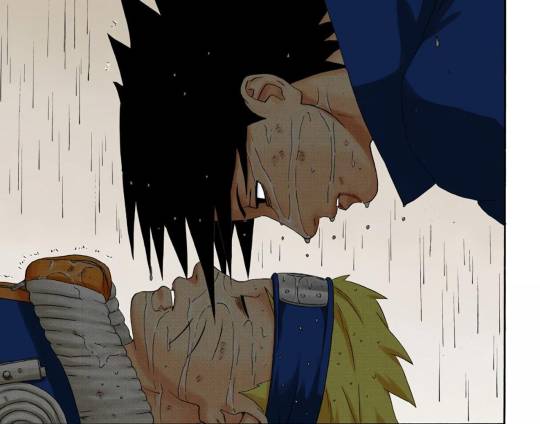
And it's a clear visual symbolism of the iconic Upside down Kiss between Mary Jane and Peter Parker in the Rain (2002)

There is no denying the fact that this romantic visual symbolism was given to Sasuke innocently staring at Naruto...
3. At the end of the chapter 271 Kishimoto said that he referenced "CHIKAMATSU MONZAEMON"

In the manga, Monzaemon is known as the first generation of puppet master. In fact, this is a real person who actually existed in the Edo period. It is taken from the famous Japanese puppet theater writer "Chikamatsu Monzaemon". He was the inventor of the art of puppetry. His real name is Sugimori Nobumori, and Chikamatsu Monzaemon is his pen name. He was a Jōruri, a playwright of puppet shows and kabuki during the Edo period. And also Known as the "Shakespeare of Japan". He is considered Japan's greatest playwright, writing for both bunraku puppet theater and the kabuki stage.
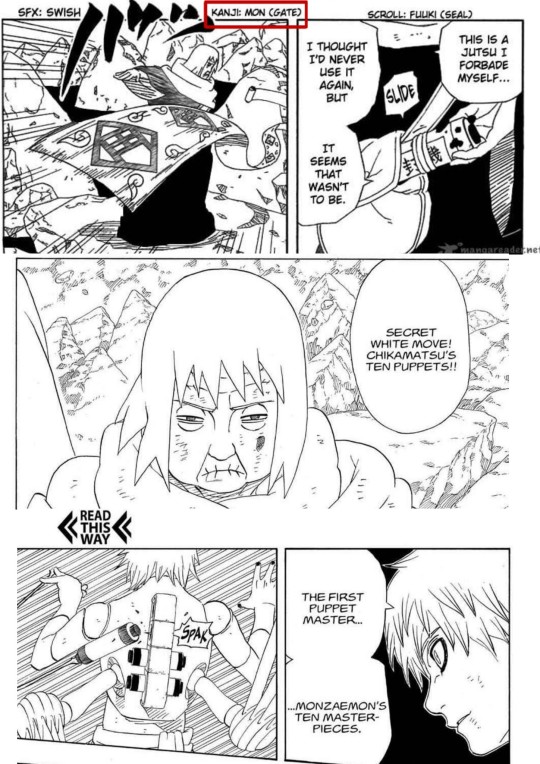
As a fan of his writings, Kishi created Chikamatsu Monzaemon as a character in his manga to show his respect for him.
As Kishi said, Chikamatsu is known as the Japanese Shakespeare. His most famous work is 'Love Suicide at Amijima' (1720). It is about two lovers who cannot live together because of social and political situation, and so blinded by love they commit the gravest act, suicide. Since their inflexible society makes their love impossible, Jihei and Koharu will seek to be joined in the afterlife. I've talked about it in here [It is based on the bunraku play The Love Suicides at Amijima by Monzaemon Chikamatsu]
Kishi talked about love suicide in the final note of chapter 271, then he mentioned double suicide in chapter 450, and finally in 486 Naruto suggested double suicide to Sasuke under a bridge

Their shinobi world is no different from the real world when it comes to the basics. A world full of injustice, inflexible and prejudice...and it won't allow their love or let them be together. If they wanted to be together forever, the only option before them was to die together. Leaving this world to live with each other. Hopefully they will meet again in the next life….because in their next life they will not be burdened by society's expectations, hatred, injustice, prejudices and rigid rules.
140 notes
·
View notes
Text
Sasori Akasuna

E chegamos em novembro... e nosso representante é SASORI AKASUNA...
"A arte é algo maravilhoso que é deixado muito tempo no futuro… uma beleza eterna."
CURIOSIDADES Sasori (蠍) significa "escorpião". Sasori tem a mesma data de nascimento de Masashi Kishimoto.
Além disso, sua data de nascimento (08 de novembro) é o signo ocidental Escorpião. Sasori teve um dos momentos de mais longa batalha no anime (8 episódios completos), dando-lhe cerca de três horas de batalha.
Na primeira pesquisa ele estava em (a sexta enquete no total), ele colocou 6º na lista. Na segunda pesquisa ele estava na oitava posição. Sasori fez uma breve aparição no omake do episódio 129 de Naruto Shippūden, passando por Sakura Haruno e Naruto Uzumaki em um festival olhando para Sakura Segundo o databook: *Seu hobby era remodelar a sua coleção de marionetes. *Sasori desejava lutar contra o Monzaemon Chikamatsu. *Sasori não precisa de comida. Sasori tinha completado 72 missões oficiais no total: 5 rank D, 12 rank C, 16 rank B, 29 rank A e 10 rank S. *A frase favorita de Sasori era "Beleza eterna".
#acnproject#projeto naruto#naruto#fanfics portugues#fanfics naruto#spirit fanfics#sasori#sasori akasuna
18 notes
·
View notes
Text




寺社訪問レポ〜大阪編
「お初天神と猫」
梅田駅徒歩7分の好立地にある、お初天神(露天神社)。
近松門左衛門の「曾根崎心中」の舞台として有名な神社です。
今回は2匹の猫ちゃんにお出迎えされました。
猫と神社の組み合わせって良いですよね😊
ビル&商店街の真っ只中にある癒しスポットでした。
大阪の寺社ご紹介はこれで一旦終わりです。
これからはまた制作&作品のご紹介をしていければと思います🍀
About Temples and Shrines in Osaka
“Ohatsu-Tenjin and Cats ”
Ohatsu-Tenjin is a shrine It takes about 7 minutes from Umeda station. This shrine is famous for the stage of “Sonezaki Sinjyu” written by Monzaemon Chikamatsu.
I found two cats in this shrine. I feel that the combination cats and shrines is wonderful view. This shrine is a comfortable spot to get relief though it is around buildings and shops.
This is the final post to recommend temples and shrines of Osaka.Next I will post my daily life of making works.
8 notes
·
View notes
Photo

Chikamatsu Monzaemon, The Love Suicides at Amijima (trans. Donald Keene)
14 notes
·
View notes
Text









"We may die in different places, our bodies may be pecked by kites and crows, but what does it matter as long as our souls are twined together? Take me with you to heaven or to hell!"
The love suicides at Amijima, Monzaemon Chikamatsu
124 notes
·
View notes
Note
crackhead headcannon.
if you look closely at the fight between Sasori and Granny Chyio you'll see that one of her puppets looks too much like Mito and fights with two big ass swords.
Those puppets where created (built) by Chikamatsu Monzaemon, the dude who invented puppeteering, so those puppetes are old as shit.
my headcannon is that Monzaemon knew Mito, not on a personal level, but he probably saw her or faced her in battle and built a puppet that looks and fights like her.
(or he got the hots for her and since she was married he built a Mito for himself and disguised it as a fightig puppet, whatever floats your boat)
Which means Mito would run into battle dual wielding two big ass swords chopping people off like they were made of butter.
this headcannon is solely based on the fact one of Grany Chiyo's puppets has redhair styled into two hair buns.

had to look up chiyo's puppets bc i didn't remember them anymore - and you're right, one of their designs looks similar to mito
i absolutely love the thought of mito fighting not only with one but two swords - give my gal some weapons fr!! - and someone being so awed by her that he'd craft a weapon after her. she deserves it
also, hashirama's face would be priceless. "chikamatsu did what??? *sweating* ahahaa shit how do i beat that?"
idk who "kartos" is that you're referring to in the second ask but mito fighting with chains and swords is a god tier headcanon
7 notes
·
View notes
Note
Hi. I apologize for the delayed response. I've been busy with Lunar New Year celebrations, and unfortunately, I haven't had the chance to check Tumblr until now. Here are the links that I sent in the foreshadowing ask https://www.tumblr.com/maoam/740334141571219456/chapter-182-beginning-of-sasuke-retrieval?source=share and https://maoam.tumblr.com/post/689252113529847808/narutos-feelings-in-kage-arc. I also apologize that I should have considered the possibility of you being wary about clicking on unknown links, especially given the current complex state of network security. I simply wanted to ensure my ask appeared tidy.
Hello there, I know you sent me an ask a long time ago about my opinion on these posts, I don't know Japanese so I can't say for sure if what she translated is correct.
What I can tell you, is that suicide amongst Japanese warriors was a practice that was considered the epitome of self-sacrifice towards an ideal. It was also an undying proof of loyalty, the ethos of Bushidō:
Ideas of the samurai code formalized earlier samurai moral values and ethics, most commonly stressing a combination of sincerity, frugality, loyalty, martial arts mastery, honor until death, "bravery", and "loyalty to the samurai's lord." The idea of a samurai code or codes was developed and refined centuries before the Edo period in the Kamakura period. (Source) Seppuku (切腹, lit. 'cutting [the] belly'), also called harakiri (腹切り, lit. 'abdomen/belly cutting', a native Japanese kun reading), is a form of Japanese ritualistic suicide by disembowelment. It was originally reserved for samurai in their code of honour, but was also practised by other Japanese people during the Shōwa era (Source)
I don't understand the comparison, regardless. Why do they claim a character (Darui) speaking of double suicide directly relates to Naruto speaking of dying alongside Sasuke (they used Japanese raws in one image, not in the other one, so I'm not sure the possible interpretation of the Japanese writing, did Naruto use the same "心中" that Darui used?).
The first example they present is from a specific character and his arc (Shikamaru), is he who introduces the notion (women being a problem), and is he who closes it, modifying his views (for a specific woman, Temari).
In the second case, it's Darui who introduces the notion (in a single bubble speech, not an entire page like Shikamaru to convey the relevance of his views), so how come is Naruto the one who closes it?
There's no mention of suicide, either, Naruto claims they'll die together, but the context implies a clash, a fight between them both, not a double suicide; furthermore, Naruto's statement is "If we really do take this all the way to the end, and we both die..." He's not choosing to die, and he's not looking forward to it either, he's listing it as a possibility, that if it happened, it'll mean that in the next life, they'd have no burden of being an Uchiha or a jinchüriki, being able to understand one another without that weight upon them. Having a "clean slate" to understand one another, of sorts...
Kishimoto used the name Monzaemon Chikamatsu as the creator of puppetry ninjutsu, and he is one of the most well-respected Japanese authors. Indeed, Chikamatsu was better known for his double-suicide stories (alongside his reflection of commoners within his plays), but Kishimoto likely used this name because Chikamatsu was, well, a japanese playwright of the jōruri, puppet theatrical art, ancestor of bunraku and kabuki; so likely his homage has more to do with Chikamatsu being "the father" of puppet plays, and less to do with the idea of "double suicide" (Chikamatsu is also mentioned in a completely different arc by Sasori when fighting Chiyo, there's no mention about his stories but rather, his relevance as a puppeteer).
About the second post... I don't know what to say, Hinata confesses as she ends her speech with "I love you, Naruto-kun", while Naruto finishes it with "I'm happy I knew you", the speeches are similar as they both focus on the influence of the other person in their lives and how they inspired them to move forward in their goal; they both idealized the other (Hinata -> Naruto / Naruto -> Sasuke) so in that front, I understand the parallelism.
Naruto uses this speech to morally downgrade Sasuke ("one bad move... and I could have been like you..."). Hinata's confession focuses on how she wants to be beside Naruto, moving alongside him, Naruto's speech is mostly about how he wants to "surpass" Sasuke (their fallout starts when Sasuke refuses to acknowledge Naruto).
I don't understand the "notice how Hinata is facing away from Naruto while confessing, while Naruto is facing Sasuke. It’s the same thing whenever Sakura is confessing, Sasuke always gives her his back. This is again intentional from Kishi." The reasoning is different: Sasuke turns his back towards Sakura because he doesn't want to face her (there's rejection, yes), and Hinata has her back turned because she's facing Pain. Naruto is paying attention to her. Meanwhile, Sasuke and Naruto are facing one another because they're the ones about to fight, so the context in each situation is completely different.
9 notes
·
View notes
Photo



The Lovers’ Suicides at Sonezaki by Chikamatsu Monzaemon, as found in The Penguin Book of Japanese Verse
wenzhou + literary quotes (9/∞)
105 notes
·
View notes
Text


Kishi respects Chikamatsu Monzaemon so much that he made him a character in his manga. The creator of puppet ninjutsu.
30 notes
·
View notes